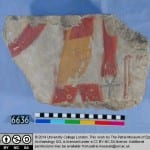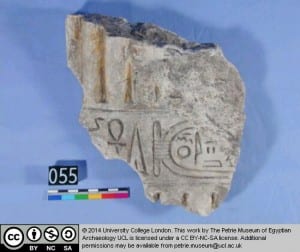Question of the Week: What is the meaning of that funny loop-headed cross symbol?
By Lisa, on 2 April 2014
Two American tourists who visited the Petrie last week spotted a pattern amongst the architectural sculpture and stelae gallery – a recurrence of a cross shaped symbol with a looped top, popping up in rows of hieroglyphs or in the hands of a god or pharaoh. They asked what it was, and what it meant? The first question is easy to answer, the second far less so.
The symbol is known as an ankh, and can be used as a stand-alone symbol or as a hieroglyphic character for the same syllable, for example in the name Tut-ankh-amun. It is widely thought to symbolise life. Therefore, in the case of Tutankhamun, the name can be translated as the Living Image of Amun, and when written you see the ankh symbol towards the end of the name, as follows:
The Ankh appears on the Rosetta Stone, the hieroglyphic content of which was translated in 1822 by a French scholar called Jean-François Champollion. In reference to Ptolemy V, it is shown in a group of three symbols that recurs frequently in or after the names of pharaohs or their households – ankh, wedjeh, seneb – meaning life, prosperity, health.
But why was this the symbol chosen to represent life? When Thomas Inman published Ancient Pagan and Modern Christian Symbolism in 1869, he interpreted the loop of the handle as female, and the three prongs of the cross as male – together forming a union that suggested fertility and the origins of life. Since then, many scholars have relinquished the female element from the sign altogether, and solely linked it with the male sexual organ and therefore the source of life. These interpretations are strengthened by links between the ankh and similarly penis sheaths, although there are arguments about which came first, and whether indeed the effect was deliberate or just coincidental! Even Petrie himself, however, noted similarities between the ankh and a fisherman’s girdle! [1]
For Gordon and Schwabe, writing in 2004, the ankh, djed, and was symbols are derived from the importance of cattle in ancient Egyptian society, and are taken as representations of this. Accordingly, the shape of the ankh is interpreted as the cross-section of the thoracic vertebra of a bull [2]. But can this really be the case? What do you think? Why not look out for the ankh on your next visit to the Petrie Museum.
[1] Petrie, William Flinders (1892) Medum
[2] Gordon, Andrew Hunt and Schwabe, Calvin W (2004). The Quick and the Dead: Biomedical Theory in Ancient Egypt
4 Responses to “Question of the Week: What is the meaning of that funny loop-headed cross symbol? ”
- 1
-
2
MrsShieldsatron wrote on 3 April 2014:
My new Question of the Week post about the ankhs in the @PetrieMuseEgypt is online now @ResearchEngager http://t.co/nS44HvtdM2
-
3
PetrieMuseEgypt wrote on 3 April 2014:
RT @MrsShieldsatron: My new Question of the Week post about the ankhs in the @PetrieMuseEgypt is online now @ResearchEngager http://t.co/nS…
-
4
Christine_Mout wrote on 3 April 2014:
RT @MrsShieldsatron: My new Question of the Week post about the ankhs in the @PetrieMuseEgypt is online now @ResearchEngager http://t.co/nS…
 Close
Close






@MrsShieldsatron answers new question of the week from visitors at the @PetrieMuseEgypt: http://t.co/WFXDU479WB